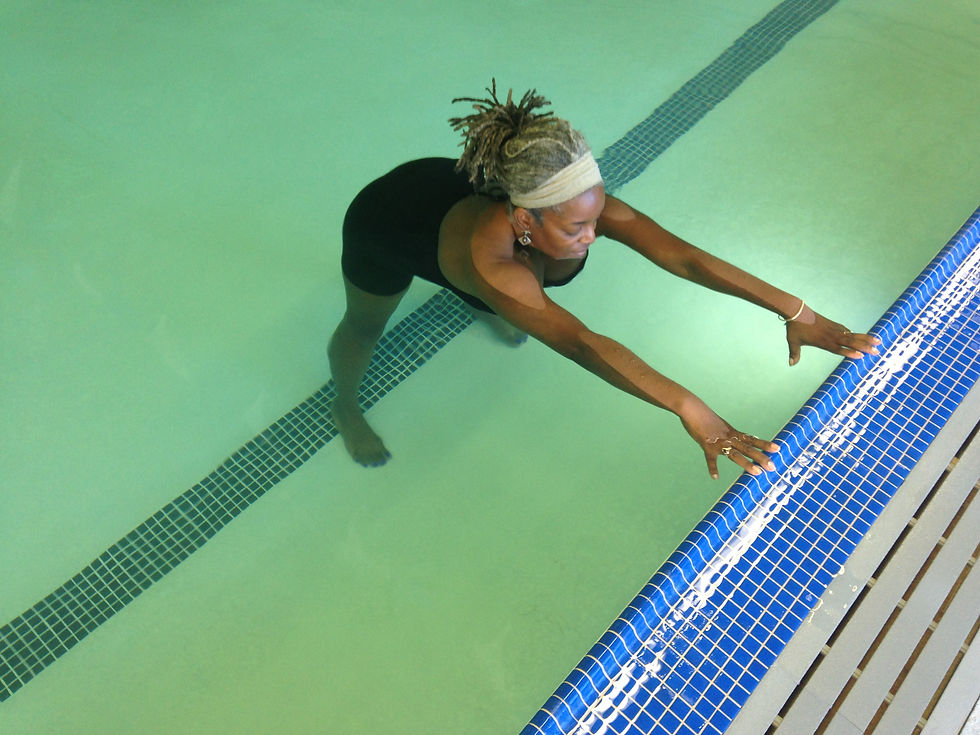Arthritis/Fibromyalgia and Aqua Yoga
- Camella Nair C-IAYT, ATRI-C (Swami Nibhrtananda)
- Nov 23, 2016
- 3 min read
Arthritis is a degenerative disease, experienced as inflammation within joints and connective tissue. The neck, lower back and knee joints in particular can be stiff and often painful. Poor circulation, especially in the hands and feet is also a common complaint, but generally there may a feeling of overall feebleness in the body. If it stopped there, that might not be quite so hard to endure. But then, feebleness of the mind may also be a factor as a sedentary lifestyle can command life's center stage. It all points to us needing to move the body more, not less and increase respiration and cardiovascular activity.
If the body is weak, stiff and painful, exercise may be the last thing someone who is suffering from arthritis or FML may want to do. By 2040, CDC forecasts that 78 million or 26% of the american population over 18 will be diagnosed with arthritis. Staggering statistics, but perhaps enough to motivate exercise providers to create more programs to help this growing population. For those who gravitate towards mindful practices, yoga in a non-gravitational and largely pain free environment, may be a welcome option.

Fear as a psychological state of consciousness is linked to the root chakra and the planet Saturn, constriction and fear. Fear of falling can prevent people exercising at all which further contributes to issues with the cardio/resp systems and feeble health.
Actions are slowed down considerably in the water so we have a chance to correct posture and condition muscles to enable us to stand up strong on land and improve our well-being.
Warmer water is recommended for this population. A recommended broad range of 84-92 degrees means that some people need to wear a wet suit or neoprene clothing to keep warmer. Better that than not exercise at all in the medium that can help mobility. Submerging what hurts is good protocol, and focusing on strengthening the spine along with trunk stability can help avoid future falls.

It does not matter if people come to a yoga practice later on in life, as both familiar and unfamiliar moves can help to to stimulate brain nerve cells. Bringing body, mind and breath together as a yoga practice can be made accessible to diverse and under-served people in the water. The yoga community is now starting to reach out to people in the water with arthritis, who are comfortable exercising there now anyway, This is a step in the right direction to meet the baby boomer demand for mindful and accessible yoga exercise. Facilities that have pools and also provide yoga classes on land are in a very prominent position to build more yoga offerings and bridges for a lifetime of uninterrupted hatha yoga.

Benefits of being in water;
Water on skin awareness – kinesthetic feedback
Water resistance great for muscle reconditioning
Gentle tugging at end of bones using water drag help trigger remodeling.
Can safely practice stop/start and balance moves(re -patterning)
Decreases joint inflammation.
Increases ROM
Buoyancy helps to eliminate pain in joints
Decompresses joints.
Resistance of water on all plains helps improved balance transfer to land.
Groups of women especially help produce oxytocin and stress releasing.
Manage varying symptoms
Deep water exercise can be used for flare-ups with use of belts and other flotations.

Moving, and in particular within a social setting, is an important de-stress protocol,especially with aging populations. Reduced mental stress is important especially those who suffer from fibromyalgia, and interestingly enough focusing on the physical body helps people step outside the mind, at least for a while.

Postures that cultivate Apana (grounding) and Samana (hugging in) Vayu's or energies might be a meaningful focus for populations that are aging and feature more air in their constitution that is seen as dry, brittle and fragile. Enjoying life to its fullest need not take a back seat as stretching, breathing and soothing painful areas has its incubator in the healing water.

What to Practice;
Water walking and smooth movements.
Submerge painful joints.
Slow movements
Breathing
Core muscle strength for fall prevention/recovery.
Fine motor skills.
Relaxed grip with prop usage or holding on to wall.
Enjoy the journey rather than striking a 'final' pose.
Work heart, blood, brain kidneys/urinary organs.
Strengthen arm bones radius/ulna and wrists,ankles, feet
Strong,mobile spine (combat kyphosis and make postural corrections)
Create connections and smile.
Bringing people to a yoga studio or class or even yoga therapy may not be the first choice of people who suffer from arthritis and are already densely populating aqua fitness classes. What is needed now to balance out the options for aging populations is more accessible yoga. The potential students are already in the water. Now we need more yoga teachers to take the plunge and dare to step off of the yoga mat.
In the Kriya Dharma
camella
for more information on teacher training check out www.aquakriyayoga.com
"Aqua Kriya Yoga" book is available on Amazon. for hosting training events email camyoga@gmail.com

.jpg)




























Comments